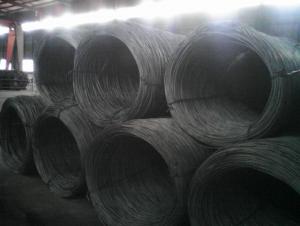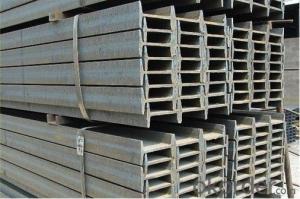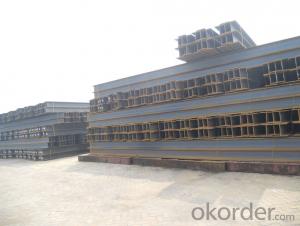carbon steel H BEAM for construction JIS G 3192
- Loading Port:
- Tianjin
- Payment Terms:
- TT or LC
- Min Order Qty:
- 25 m.t.
- Supply Capability:
- 100000 m.t./month
OKorder Service Pledge
OKorder Financial Service
You Might Also Like
Product Description:
OKorder is offering carbon steel H Beam for construction JIS G 3192 at great prices with worldwide shipping. Our supplier is a world-class manufacturer of steel, with our products utilized the world over. OKorder annually supplies products to European, North American and Asian markets. We provide quotations within 24 hours of receiving an inquiry and guarantee competitive prices.
Product Applications:
Carbon steel H Beam are ideal for structural applications and are widely used in the construction of buildings and bridges, and the manufacturing, petrochemical, and transportation industries.
Product Advantages:
OKorder's steel H Beam are durable, strong, and resist corrosion.
Main Product Features:
· Premium quality
· Prompt delivery & seaworthy packing (30 days after receiving deposit)
· Corrosion resistance
· Can be recycled and reused
· Mill test certification
· Professional Service
· Competitive pricing
Product Specifications:
1. Standard: JIS
2. Grade: SS400
3. Length: 12m
4. Invoicing on theoretical weight or actual weight as customer request
5.Payment: TT or L/C
6. Sizes:
H x B
(mm)
| T1 | T2 | JIS Weight
(kg/m)
| GB Weight
(kg/m)
|
100*100 | 6 | 8 | 16.9 | 17.2 |
125*125 | 6.5 | 9 | 23.6 | 23.8 |
150*75 | 5 | 7 | 14 | 14.3 |
148*100 | 6 | 9 | 20.7 | 21.4 |
150*150 | 7 | 10 | 31.1 | 31.9 |
175*90 | 5 | 8 | 18 | 18.2 |
175*175 | 7.5 | 11 | 40.4 | 40.4 |
198*99 | 4.5 | 7 | 17.8 | 18.5 |
200*100 | 5.5 | 8 | 20.9 | 21.7 |
194*150 | 6 | 9 | 29.9 | 31.2 |
200*200 | 8 | 12 | 49.9 | 50.5 |
248*124 | 5 | 8 | 25.1 | 25.8 |
250*125 | 6 | 9 | 29 | 29.7 |
244*175 | 7 | 11 | 43.6 | 44.1 |
250*250 | 9 | 14 | 71.8 | 72.4 |
298*149 | 5.5 | 8 | 32 | 32.6 |
298*201 | 9 | 14 | 65.4 | |
300*150 | 6.5 | 9 | 36.7 | 37.3 |
294*200 | 8 | 12 | 55.8 | 57.3 |
300*300 | 10 | 15 | 93 | 94.5 |
346*174 | 6 | 9 | 41.2 | 41.8 |
350*175 | 7 | 11 | 49.4 | 50 |
340*250 | 9 | 14 | 78.1 | 79.7 |
350*350 | 12 | 19 | 135 | 137 |
400*200 | 8 | 13 | 65.4 | 66 |
390*300 | 10 | 16 | 105 | 107 |
400*400 | 13 | 21 | 172 | 172 |
446*199 | 8 | 12 | 65.1 | 66.7 |
450*200 | 9 | 14 | 77.9 | 79.5 |
440*300 | 11 | 18 | 121 | 124 |
496*199 | 9 | 14 | 77.9 | 79.5 |
500*200 | 10 | 16 | 88.2 | 89.6 |
488*300 | 11 | 18 | 125 | 129 |
596*199 | 10 | 15 | 92.5 | 95.1 |
600*200 | 11 | 17 | 103.4 | 106 |
588*300 | 12 | 20 | 147 | 151 |
700*300 | 13 | 24 | 182 | 185 |
800*300 | 14 | 26 | 207 | 210 |
900*300 | 16 | 28 | 240.1 | 243 |
FAQ:
Q1: How do we guarantee the quality of our products?
A1: We have established an advanced quality management system which conducts strict quality tests at every step, from raw materials to the final product. At the same time, we provide extensive follow-up service assurances as required.
Q2: Can stainless steel rust?
A2: Stainless does not "rust" as you think of regular steel rusting with a red oxide on the surface that flakes off. If you see red rust it is probably due to some iron particles that have contaminated the surface of the stainless steel and it is these iron particles that are rusting. Look at the source of the rusting and see if you can remove it from the surface.
Images:



- Q: Are steel H-beams available in different finishes or coatings?
- Yes, steel H-beams are available in different finishes and coatings. These can include options such as galvanized coating, primer coating, or painted finishes, among others, depending on the specific requirements and applications.
- Q: What are the cost implications of using steel H-beams?
- The cost implications of using steel H-beams can vary depending on various factors. Firstly, the cost of steel H-beams themselves can significantly impact the overall project budget. Steel is a widely used construction material due to its strength and durability, but it can be more expensive compared to other materials like wood or concrete. The price of steel H-beams is influenced by factors such as market demand, supply chain dynamics, and global economic conditions. Additionally, the size and dimensions of the H-beams can affect their cost. Larger and heavier H-beams will generally be more expensive as they require more steel material and may require specialized handling and transportation. Furthermore, the cost implications of using steel H-beams extend beyond the material itself. Considerations such as fabrication, installation, and maintenance expenses should also be taken into account. Fabrication costs usually include cutting, welding, and shaping the steel beams according to the project's specifications. Installation costs involve labor, equipment, and any necessary support structures. Finally, ongoing maintenance costs should be factored in, as steel requires periodic inspections, painting, and potential repairs to ensure its longevity. However, it's essential to consider the long-term benefits of using steel H-beams. Their high strength-to-weight ratio and durability make them a reliable choice for structural applications. Steel H-beams have a longer lifespan compared to other materials, reducing the need for frequent replacements or repairs. This can result in cost savings over time, as the initial investment in steel H-beams can offset the expenses associated with maintenance and replacement in the future. Ultimately, the cost implications of using steel H-beams should be evaluated in the context of the specific project requirements, budget constraints, and long-term considerations. Consulting with professionals in the construction industry, such as engineers or contractors, can provide a more accurate assessment of the cost implications and help make informed decisions.
- Q: Can steel H-beams be used for cantilever structures?
- Yes, steel H-beams can be used for cantilever structures. The structural properties of H-beams, such as their strength, stiffness, and ability to distribute loads, make them suitable for supporting cantilevered beams or structures that extend beyond their support points.
- Q: What are the different surface treatments available for steel H-beams?
- Steel H-beams have several surface treatment options, each with its own unique benefits and characteristics. The commonly used treatments are as follows: 1. Hot-dip galvanizing: To provide a durable and corrosion-resistant coating, the steel H-beam is immersed in molten zinc. This method is known for its excellent corrosion protection and is ideal for outdoor applications where the beams are exposed to moisture, chemicals, or harsh environments. 2. Powder coating: This dry finishing process involves applying a powdered polymer to the H-beam's surface using electrostatics. The coated beams are then cured under heat, resulting in a long-lasting and visually appealing finish. Powder coating offers corrosion resistance, impact resistance, UV protection, various color options, and the ability to achieve specific aesthetics. 3. Epoxy coating: A liquid protective coating, epoxy is applied and cured to form a hard, durable film. It provides outstanding adhesion, chemical resistance, and corrosion protection. Epoxy coatings are commonly used in industrial and marine applications where the beams face aggressive environments such as chemicals, saltwater, or high humidity. 4. Paint: Painting is a simple and cost-effective option where a layer of paint is applied to the H-beam surface. It creates a protective barrier against corrosion and enhances the appearance. Depending on specific requirements, various types of paint coatings, such as epoxy, polyurethane, or acrylic, can be used. 5. Metal plating: A thin layer of metal, such as chrome, nickel, or zinc, is deposited onto the steel H-beam surface. Metal plating offers improved corrosion resistance, enhanced appearance, and increased durability. It is suitable for decorative or high-end applications that require an attractive finish or protection against wear and tear. These examples highlight the available surface treatments for steel H-beams. The choice of treatment depends on factors such as the intended application, environmental conditions, desired aesthetics, and budget. It is crucial to carefully consider these factors and seek professional advice to determine the most suitable treatment for specific requirements.
- Q: How do Steel H-Beams contribute to the overall acoustic performance of a building?
- Steel H-Beams do not directly contribute to the acoustic performance of a building. Their primary function is to provide structural support and load-bearing capacity. However, their rigid and sturdy nature can help minimize vibrations and structural movement, which indirectly may have a positive impact on reducing noise transmission within the building.
- Q: How do steel H-beams contribute to energy-efficient building designs?
- Steel H-beams contribute to energy-efficient building designs due to their high strength-to-weight ratio, which allows for the creation of structurally efficient buildings. The use of H-beams allows for the construction of longer spans and taller buildings, reducing the need for additional support columns and minimizing energy loss. Additionally, their durability and resistance to bending or warping ensure long-term stability, reducing the need for maintenance or replacement.
- Q: What are the considerations when designing for accessibility in Steel H-Beams?
- When designing for accessibility in Steel H-Beams, there are several key considerations to keep in mind: 1. Clearances and dimensions: It is important to ensure that there is sufficient clearance around the H-Beams to accommodate wheelchair users or individuals with mobility aids. This includes providing enough space for maneuverability and ensuring that doorways, ramps, or other access points have appropriate dimensions to allow for easy passage. 2. Ramps and slopes: When designing ramps or slopes to provide access to H-Beams, it is crucial to adhere to accessibility guidelines and standards. This includes ensuring the slope is within the recommended limits, providing handrails for support, and considering the surface texture to prevent slipperiness. 3. Handrails and guardrails: Implementing handrails and guardrails along walkways or staircases near H-Beams is essential for ensuring safety and accessibility. These features should be designed to meet accessibility standards, including proper height and clearance, and provide a secure grip for users. 4. Surface materials and textures: The choice of surface materials and textures for H-Beams should be carefully considered to enhance accessibility. Slip-resistant surfaces are critical to prevent accidents, especially in wet or icy conditions. Additionally, tactile indicators or markings can be incorporated to assist individuals with visual impairments in navigating the area. 5. Signage and wayfinding: Clear and visible signage is crucial for guiding individuals to H-Beams and ensuring they can easily locate them. Using contrasting colors, large fonts, and braille signage can significantly improve accessibility for people with vision impairments. 6. Lighting and visual contrast: Adequate and well-distributed lighting is essential for accessibility in areas with H-Beams. This helps individuals with visual impairments to navigate safely. Additionally, ensuring sufficient visual contrast between the H-Beams and their surroundings can aid individuals with low vision in identifying and distinguishing them. 7. Universal design principles: Incorporating universal design principles into the accessibility considerations for Steel H-Beams can greatly enhance usability for a wide range of individuals. This includes ensuring that the design accommodates people of all abilities, ages, and sizes, and considering factors such as adjustability, reachability, and operability. By considering these factors, designers can create Steel H-Beams that prioritize accessibility, ensuring that they are safe, usable, and inclusive for all individuals, regardless of their physical abilities.
- Q: Are steel H-beams resistant to impact or vibration?
- Steel H-beams are known for their excellent strength and durability, making them highly resistant to impact and vibration. The design of H-beams, with their wide flanges and thick web, allows them to distribute forces evenly and efficiently, minimizing the effects of impact and vibration. The inherent properties of steel, such as its high tensile strength and elasticity, contribute to its ability to withstand external forces. When subjected to impact, steel H-beams have the capacity to absorb and dissipate the energy generated by the impact, preventing any significant damage or deformation. This makes them suitable for applications where impact resistance is crucial, such as in construction, bridges, and high-rise buildings. Similarly, steel H-beams exhibit remarkable resistance to vibration. Their robust construction eliminates the risk of excessive deflection or oscillation when subjected to vibrational loads. This makes them ideal for structures that are exposed to various types of vibrations, such as machinery, heavy equipment, and seismic loads. However, it's important to note that the specific resistance to impact and vibration of steel H-beams can vary depending on factors such as the quality of the steel used, the design of the beam, and the magnitude and frequency of the forces applied. In certain situations, additional measures such as dampers or vibration isolation systems may be necessary to further enhance their performance. Overall, steel H-beams are well-regarded for their exceptional resistance to impact and vibration, making them a reliable choice for a wide range of structural applications.
- Q: Can steel H-beams be used for supporting industrial silos or storage tanks?
- Yes, steel H-beams can be used for supporting industrial silos or storage tanks. The H-beams provide excellent structural support and stability, making them a suitable choice for such applications. The high strength and load-bearing capacity of steel H-beams make them capable of withstanding the weight and pressure exerted by silos or storage tanks, ensuring the overall integrity and safety of the structure.
- Q: How do steel H-beams perform in snow-prone areas?
- Due to their structural integrity and strength, steel H-beams are well-suited for areas with heavy snowfall. Their H-shape design provides resistance against bending and twisting forces, making them suitable for handling substantial snow loads. The efficient weight distribution design of H-beams also reduces the risk of structural failure caused by accumulated snow. Furthermore, steel is a durable material that is unaffected by extreme cold temperatures or moisture, making it highly resistant to corrosion and deterioration from snow and ice. This durability ensures that the H-beams maintain their structural integrity even in harsh winter conditions. Moreover, steel H-beams offer versatility in construction, allowing for various designs and configurations that can meet the unique requirements of snow-prone areas. These beams can be fabricated to specific lengths and sizes, ensuring optimal load distribution and providing the necessary support to withstand heavy snowfall. In conclusion, steel H-beams are an excellent choice for construction in areas prone to snow. Their strength, durability, and versatility make them highly capable of withstanding heavy snow loads and maintaining structural integrity in challenging winter conditions.
Send your message to us
carbon steel H BEAM for construction JIS G 3192
- Loading Port:
- Tianjin
- Payment Terms:
- TT or LC
- Min Order Qty:
- 25 m.t.
- Supply Capability:
- 100000 m.t./month
OKorder Service Pledge
OKorder Financial Service
Similar products
Hot products
Hot Searches
Related keywords




























